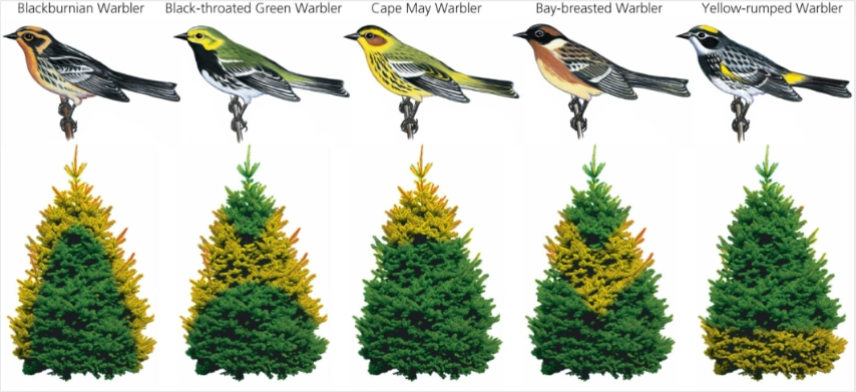CHAPTER 5 BIODIVERSITY, SPECIES INTERACTIONS, & POPULATION CONTROL
1/45
There's no tags or description
Looks like no tags are added yet.
Name | Mastery | Learn | Test | Matching | Spaced |
|---|
No study sessions yet.
46 Terms
Why care about sea otters?
• Ethics
• Tourism dollars
• Keystone species
Five types of species interactions affect the resource use and population sizes of the species in an ecosystem:
• Competition
• Predation
• Parasitism
• Mutualism, and
• Commensalism
Competition
is the common use of a resource in short supply.
interspecific Competition
is competition between individuals of different species
Intraspecific Competition
is competition between individuals of the same species.
There are many ways that organisms reduce
competition. For example
hunting at night instead of during the day, stratification, marking territories, etc.
Competitive Exclusion Principle
No two species can have the exact same niche.
One will be a better competitor and eliminate the other.
Resource partitioning
• Using only parts of the resource
• Using at different times
• Using in different ways
example of resource partitioning

Predation
is when one species feeds on another
Predators have evolved many methods to capture prey. For example
cooperation, speed, etc.
Prey tend to be old, sick, disabled, etc.
Prey may avoid capture by
Speed - run, swim, fly
2. Protection: shells, bark, thorns
3. Camouflage
4. Poison - chemical warfare
5. Warning coloration
6. Mimicry
7. Deceptive looks
8. Deceptive behavior
Predators may capture prey by
1. Speed – walking, swimming, flying
2. Pursuit and ambush
3. Camouflage
4. Chemical warfare
5. Cooperation
prey tend to be
old, sick, disabled, etc.
Coevolution
the simultaneous evolution of two species
The evolution of one species in the coevolution relationship is partially dependent on the
evolution of the other
examples of coevolution
pollinators and flowers.
Bats and moths: echolocation of bats and sensitive hearing of moths, fuzz on moths
Parasitism
Parasite is usually much smaller than the host
Parasite rarely kills the host
Parasite-host interaction may lead to coevolution
Both plants and animals have parasites.
Mutualism
Is a relationship between two species in which both benefit.
examples of Mutualism
• Flowers & their pollinators
• Nutrition
• Protection relationship
• Gut inhabitant mutualism
Hummingbirds and Flower, Oxpeckers and Black Rhinoceros, Clownfish & Sea Anemones
Commensalism
Is a relationship between two species which is beneficial to one, but neutral or of no benefit to the other
examples of commensalism
• barnacles on whales
• epiphytes
• birds nesting in trees
• remoras on sharks
Range of tolerance
is the range of physical and chemical conditions that must be maintained for populations or a particular species to stay alive and grow normally
Each organism has a particular range of
tolerance
Limiting factor principle
Too much or too little of any physical or chemical factor can limit or prevent the growth of a population, even if all other factors are at or near the optimal range of tolerance
Limiting Factor
Is the single factor that limits the growth abundance or distribution of a particular organism in the ecosystem
A limiting factor can be
too much or too little temperature, water, sunlight, nutrients, etc
in aquatic ecosystems, examples of limiting factors are
salinity and dissolved oxygen content.
Population change
(births + immigration) – (deaths + emigration)
Population crash
A population exceeds the area’s carrying capacity
Reproductive time lag may lead to overshoot
Damage may reduce area’s
carrying capacity
Carrying capacity (K)
Maximum population a given habitat can sustain
A population can exceed its habitat’s carrying capacity and
crash
Ecological Succession
is the replacement of one community by another.
Ecological Succession example
take a new volcanic island or a forest cleared by man
First come the pioneer species
the first step in succession They invade or colonize the area, and usually create soil from rock.
This makes the environment more suitable for other species
The mature or climax community
is the stable, end community of succession that is capable of self-perpetuation.
There are two kinds of succession:
• Primary Succession
• Secondary Succession
Primary succession
is the sequential development of communities in a bare area that has never been occupied by a community of organisms.
Examples of primary succession
sand dunes, bare rock, volcanic island
• No soil in a terrestrial system
• Takes hundreds to thousands of years
• Need to build up soils/sediments to provide necessary nutrients
Secondary succession
is more common, is
the sequential development of communities in
an area in which natural vegetation has been
removed or destroyed (some soil remains).
Secondary succession also occurs to
ponds as they fill and are converted to forests.
examples of secondary succession
abandoned farmland, cut or burned forests, disturbed ecosystems.
Property
complexity, energy source, waste production, nutrients, net primary productivity
Natural systems
biologically diverse, renewable energy, litter, if any, recycled, shared among many species
Human dominated systems
Biologically simplified, mostly nonrenewable fossil fuel energy, high, often lost of wasted, used destroyed or degenerated to support human activities